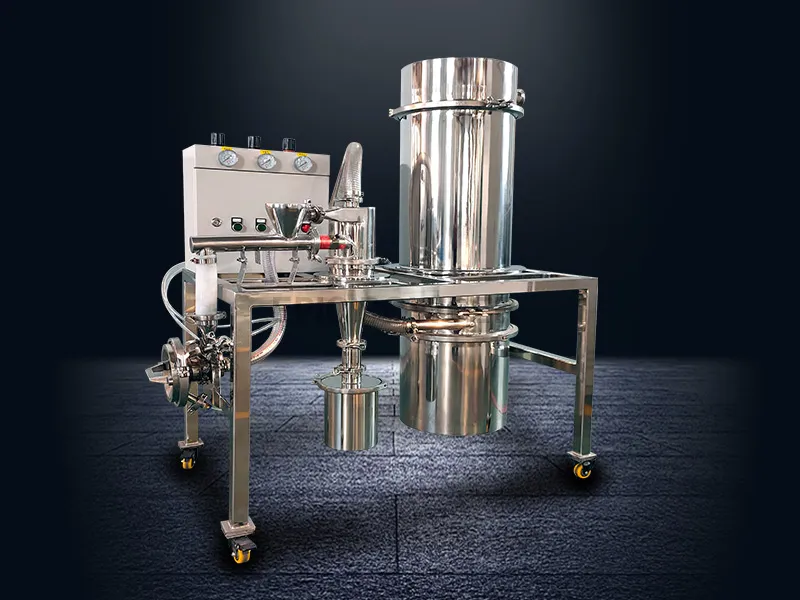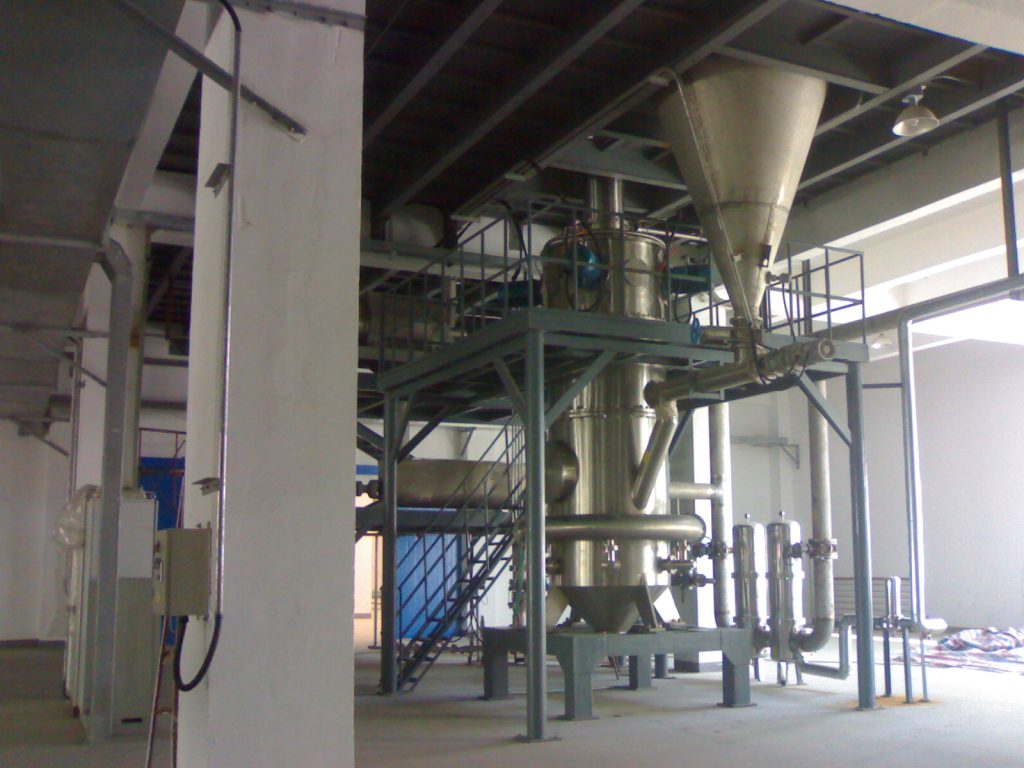In recent years with the superior performance of ultrafine particles is constantly affirmed, more and more researchers began to pay attention to the research work of microfine powder manufacturing. Air flow pulverization technology as an important method of preparation of ultrafine powder system, has become one of the preferred methods for the development of a variety of high-performance micropowder materials.
Characteristics of jet pulverizer
jet pulverizer, also known as jet mill or flow energy mill, is the use of high-speed airflow to make the material and impact parts of the collision, impact, shear and other effects of crushing.
The jet mill crushes the material to get a uniform fineness. The powder size range is narrow and the purity is high. The particles have smooth surfaces and a regular shape. They also disperse well. The material faces less pollution in crushing. It can even be done without pollution in a sterile environment. So, it can be used for food, drugs, and other areas that do not allow contamination by foreign objects with ultrafine powder. jet pulverizer in crushing makes little heat. So, it is better than other equipment for crushing low melting point or heat-sensitive materials. The process is highly automated. It can be used for large-scale production. Air pulverization can also be achieved by crushing and other production steps. For example, crushing and drying materials can be done at the same time. Air can also be sprayed into the solution during crushing. This is used for powder coating or surface modification. But there are energy consumption and other shortcomings.
Application of jet pulverizer
With many advantages, air flow pulverizer in many areas play an extremely important role.
Mining and Metallurgy
Jet pulverizing technology was first used in mining and metallurgy. It was for making ultra-fine metal or non-metallic powders. It’s widely used in talc, marble, kaolin, and mica and other non-metallic minerals below medium hardness. It’s also used for tungsten carbide powder, silver powder, tantalum carbide, and other ultra-fine powders. Also, in recent years, the airflow has begun to crush materials. This happens in the separation of materials, solid waste, and other directions. It has also shown new potential.
Military, aerospace and other fields
You can use ultrafine powder to make stealthy materials. These are for invisible airplanes, tanks, and so on. Oxidizer, catalyst, and other airflow crush and refine the products from the rocket propellant. Its combustion speed can be more than double that of ordinary propellant.
Chemical industry, energy and other fields
Titanium dioxide is a pigment. It has high standards for particle size and purity. It’s generally crushed using jet mill to meet these standards. Air flow crushing gives titanium dioxide better stability and optical properties. The jet pulverized the aluminum hydroxide. It was obtained after the catalytic properties improved. It can be used as artificial marble or as a filler for glass fiber reinforced plastic. In rubber production, crushing zinc oxide nanoparticles with airflow helps break them up. It gives a good deagglomeration effect. It also improves their dispersion in organic solvents. This can boost the vulcanization of natural rubber. In energy, crushed straw affects the formation of fermentation flotsam. This helps biogas fermentation and so raises straw energy use.
Pharmaceutical field
The jet pulverizer can pulverize many traditional Chinese medicines, like ginseng and wolfberry. It can grind these materials to 1 ~ 5μm. The resulting powder is fine, pure, and small. This is great for the drug’s dissolution and absorption. In addition, it can also pulverize the hard texture of shellfish and bones and other herbs.
Food field
Apple peel, citrus peel, wheat bran, corn husk, soybean peel, rice bran, beet residue, bagasse, etc. are rich in vitamins and trace elements. They have good nutrition. But, eating them directly tastes bad and reduces absorption. By grinding them with an air grinder, we can improve their taste and absorption.
Cosmetic field
Colorants and filler powders are crushed by airflow. Then, they are added to the foundation. This will improve the compactness, adhesion, and smoothness of eye shadow. Airflow pulverization makes andrographolide in skin care products more water-soluble. It can be dissolved quickly but still keeps its antibacterial activity. After airflow ultrafine pulverization, we add VC powder and pearl powder to skin care products. This addition will help absorption.
Electronic field
Iron oxide ultrafine powder can produce high-performance magnetic materials. Silicon oxide ultrafine powder can produce high-performance resistive materials. Ultrafine high-purity alumina powder can make sapphire substrates for LED chips. The powder makes substrates that are stable, transparent, and do not absorb visible light. Airflow crushing technology processes molybdenum powder. This makes the particles smaller and more uniform. It also narrows their distribution. It makes the powder more dense and less prone to vibration. These changes make the powder better for making light bulbs, electronic tubes, and integrated circuits.
New energy field
The material’s average particle size is fine after air flow pulverization. The particle size range is narrower. The particles have smooth surfaces and regular shapes. They are also pure, active, and well dispersed. They meet the requirements for making electrode materials. So, they are widely used. Typical materials suitable for air flow pulverizer are: lithium manganate, lithium cobaltate, lithium iron phosphate, lithium carbonate, spherical graphite, petroleum coke, asphalt coke, ternary materials, nickel-metal hydride alloy, ferrous oxalate, lithium titanate, lithium nickel-manganese, and so on.
Classification of jet pulverizer
In 1934, the United States Fluid Energy made the world’s first air mill. Its structure has been updated over time. It has been developed into a few types. These types are based on the air mill’s structure or its way of working. They include: flat air mill, jet air mill, target air mill, circulating tube air mill, and fluidized bed air mill.
Flat air mills
Flat air mill, also known as the horizontal disc air mill is the earliest and most widely used industrial air mill. It has a simple structure. It is easy to use and self-grading. It has other advantages. But, the equipment’s kinetic energy has little impact. The crushing strength is low. When dealing with hard material, the material’s high-speed airflow causes violent collision and friction with the body’s inner wall. This contamination pollutes the product to a degree. Applicable materials are wide, especially the materials composed of various aggregates or condensates.

Counter Jet Air Mill
A counter-jet airflow mill is also called a collision airflow mill or reverse jet mill. It is a kind of equipment with a high energy use rate. The crushing process relies on fast collisions between particles. This can avoid the wear of fast airflow on the impact parts and improve material contamination. It also makes the product finer. But, the equipment covers a larger area, uses a lot of energy, and has a wider particle size range. Commonly used in crushing hard, brittle, sticky materials.
Target Air Mill
Target air mill is also known as a single jet air mill. The material orientation is better. The crushing force is larger and can handle tougher material. But, the equipment’s target plate and mixing tube wear out easily and suffer serious erosion. They need regular replacement. The equipment also pollutes the material to some degree. The product size distribution is wider and it uses more kinetic energy. Commonly used in crushing polymers, low melting point of heat-sensitive, fibrous coarser materials.

Circulating tube type air flow mill
This mill is a type of airflow mill with a circulating tube (a vertical annular jet air mill). It has many advantages: small particle size distribution, no power device, and it’s not easy to contaminate or for material to stick to the wall. But, this equipment has low pulverizing efficiency, high energy consumption, and serious wear on the inner wall. It is commonly used to crush brittle, low-hardness materials. The tubes are usually divided by their cross-section. They can be equal or variable in shape.

Fluidized bed jet mill
The mill uses a fluidized bed. It is a new type of air flow mill. It has the advantages of a narrow particle size distribution, high crushing efficiency, low energy consumption, low product pollution, and low wear of accessories. But, its equipment cost is high. The material must be processed for fluidization to be crushed by the air beam. So, the mill needs the material to be fine enough and not too dense. It is commonly used in synthetic resins, phenolic resins, pharmaceuticals, cosmetics, high-grade ceramics, magnetic powder, battery materials, and other industries. It is used for ultra-fine crushing, breaking, and shaping.

Ultrafine jet pulverizing equipment has many types. The structure of each type has clear differences and has its own pros and cons. In the future, ultra-fine air crushing equipment will mainly improve in three ways. It will make each machine use less energy to make a product. It will also make the product finer and the machine better at crushing. Finally, it will regulate and control the product’s fineness and size.